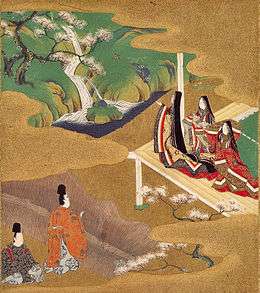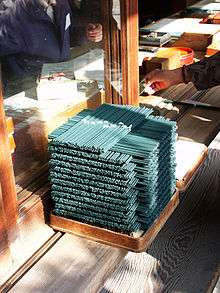Japanese incense
Japanese incense (香 (kō)) has a long history that streches back to the 6th century CE. From that point on, incense would become an important facet of Japanese culture. Incense is used for a variety of purposes, including Buddhist ceremonies, spirituality and meditation.
There are two major types of incense in Japan, which are either heating or smouldering small pieces of fragrant wood, or direct-burning incense in form of sticks or cones formed out of paste without a bamboo stick.
Many of the current incense companies have been in existence for more than 300 years.
Etymology
The word 香 kō is written in the Chinese Kangxi radical 186 composed of nine strokes, which can also be expanded up to 18 strokes 馫. Translated it means "fragrance", however in this context may also be translated as "incense".
History

According to legend, agarwood (aloeswood) first came to Japan when a log of incense wood drifted ashore on Awaji-shima island in the third year of Empress Suiko's reign (595 CE). People who found the incense wood noticed that the wood smelled marvelous when they put it near a fire. Then they presented the wood to local officials.
Japan was the eastern end of the Silk Road. Incense was brought from China over Korea and developed over 1,000 years. The history starts in the 6th century CE when Buddhism arrived during the Asuka period. Agarwood is known to have come along with the supplies to build a temple in 538 CE. A ritual known as sonaekō became established. Koboku fragrant wood combined with herbs and other aromatic substances was burned to provide a fragrant incense for religious purposes.[1] The custom of burning incense was further developed and blossomed amongst the court nobility with the pastime of takimono, a powdered mixture of aromatic substances.[2] Fragrant scents played a vital role at court life during the Heian period, robes and even fans were perfumed and poems written about them, it also featured prominently in the epic The Tale of Genji in the 11th century.
Samurai warriors would prepare for battle by purifying their minds and bodies with the incense of koboku. They also developed an appreciation for its fragrances. In the late Muromachi period in the 16th century, this aesthetic awareness would develop into the accomplishment known as kōdō, which is the art of enjoying the incense of smouldering koboku.[3] The present style of kōdō has largely retained the structure and manner of the Muromachi period, in which time the tea ceremony and the ikebana style of flower arrangement developed as well.
During the Tenshō era in the late 16th century, the master craftsmen Kōju was employed at the Kyoto Imperial Palace and practiced incense ceremony. The third Kōju served under Toyotomi Hideyoshi, the fourth under Tokugawa Ieyasu. The eighth Kōju Takae Jyuemon was known as a particular master of incense of note.
The start of the Edo period in the 19th century saw major changes in the history and production of incense. Senko incense sticks became more widely available to the general public as production method shifted to an industrial scale. At the start of the 20th century, mainichi-kō, or "everyday incense" was developed by the master craftsman Kitō Yujiro during the Meiji and Taisho era.
Today companies such as Nippon Kodo, Shoyeido, and Baieido are some of the most established suppliers for incense.
Kōdō
Kōdō (香道 (Way of Fragrance)) is the Japanese art of appreciating incense, and involves using incense within a structure of codified conduct. Though it is counted as one of the three classical arts of refinement, it is relatively unknown amongst modern Japanese people. Kōdō includes all aspects of the incense process - from the tools (香道具), which, much like tools of the tea ceremony, are valued as high art, to activities such the incense-comparing games kumikō (組香) and genjikō (源氏香).
Apart from kōdō, incense can also be used during the tea ceremony or other functions. A variety of containers and censers, or kōro (香炉), made out of porcelain, wood, lacquer or other materials were created over the centuries for this purpose, such as kōgō (香合), kōbako (香箱), all of which can be supremely valuable items.
Ingredients
The following are the main ingredients in Japanese incense:
- Agarwood (沈香 jinkō) (also called Aloeswood)
- Sandalwood (白檀 byakudan)
- Borneo Camphor (竜脳 ryūnō)
- Benzoin (安息香 ansokukō)
- Frankincense (乳香 nyūkō)
- Clove (丁字 chōji)
- Star Anise (唐樒 tōshikimi)
- Rhubarb (大黄 daiō)
- Cinnamon (桂皮 keihi)
- Licorice (甘草 kanzō)
- Patchouli (パチョリ pachori)
Many other ingredients are also used in Japanese incense. They are chosen either for their scent or properties in Traditional Chinese Medicine. Most ingredients for Japanese incense come from India and South-East Asia.
Agarwood and sandalwood are the two most important ingredients. Agarwood is known as jinkō in Japan, which translates as "incense that sinks in water," due to the weight of the resin in the wood. It is currently on the list of the Convention on International Trade in Endangered Species of Wild Fauna and Flora (CITES).
Sandalwood is one of the most calming incense ingredients and lends itself well to meditation. The most valued sandalwood comes from Mysore in the state of Karnataka in India, where it is endangered.
Another important ingredient in Japanese incense is kyara (伽羅). Kyara is one kind of agarwood (Japanese incense companies divide agarwood into six categories depending on the region obtained and properties of the agarwood).[4] Kyara is currently worth more than its weight in gold.
Makkō (抹香 or 末香) is another ingredient used in Japanese incense. Makkō actually just translates as "incense powder". The incense powder that is normally being referred to is called tabu no ki (椨の木). Makko is used to bind the ingredients together. It is remarkable for being able to bind ingredients while having little scent of its own.
Incense makers
The following are the major incense companies in Japan (alphabetical order):

- Baieidō(梅栄堂)
- Daihatsu(大発)
- Gyokushodō(玉初堂)
- Kitōtenkundō(鬼頭天薫堂)
- Kōjū(香十)
- Kōkandō(孔官堂)
- Kunjudō(薫寿堂)
- Kunmeidō(薫明堂)
- Kyūkyodō(鳩居堂)
- Nippon Kōdō(日本香堂)
- Seijudō(誠寿堂)
- Seikadō(精華堂)
- Shōeidō(松栄堂)
- Tennendō(天年堂)
- Yamada-Matsu Kōboku-ten(山田松香木店)
Baieidō was established in 1657 in Sakai City and is the oldest company in Japan. Shōeidō was established in 1705 in Kyoto Japan. Both Baieido and Shoyeido are used extensively by Zen Buddhist temples, both in Japan and worldwide. Nippon Kōdō was established by incorporation in New York City in August 1965 and is the largest seller of Japanese incense worldwide. Most of their incense is "everyday" quality (毎日 mainichi). They do make some "traditional" incense as well. These three are the major exporters of Japanese incense.
Currently, 70% of all of Japan's incense is manufactured on a small island south of Osaka called Awaji Island. The history extends back to 1850 in Ei of the city of Awaji in 1850 when Senshuu Sakai manufacturing technology was introduced. At the time, Ei was a military run trade port for the Tokushima Clan, which opened the door to the import and sale of raw materials used in making incense. Over time, the incense made in Awaji Island became renowned throughout Japan. The main reason incense manufacturing took root in Awaji Island is because of its nishi-kaze (west wind). This strong seasonal wind hampers the fishing industry, giving rise to the necessity for cottage industries such as incense making. This wind is also great for drying incense.
Kyūkyodō, Kunmeidō, and Kōkandō also sell some incense overseas. It may be difficult to find the other brands outside Japan. There are numerous other incense makers in Japan, of course. These are the either the major sellers or the oldest companies in Japan.
See also
References
Further reading
- Bincsik, Monika. “Japanese Incense.” In Heilbrunn Timeline of Art History. New York: The Metropolitan Museum of Art, 2000–. http://www.metmuseum.org/toah/hd/jinc/hd_jinc.htm (March 2009)
- Exhibition of Kôgô: Japanese Ceramic Incense Boxes from the George Clemenceau Collection. Tokyo: Asahi Shinbusha, 1978.
- Kôdô nyûmon (Introduction to “The Way of Incense”). Kyoto: Tankosha, 1998.
- Morita, Kiyoko. The Book of Incense. Tokyo: Kodansha International, 1992.
External links
| Wikimedia Commons has media related to Japanese incense. |